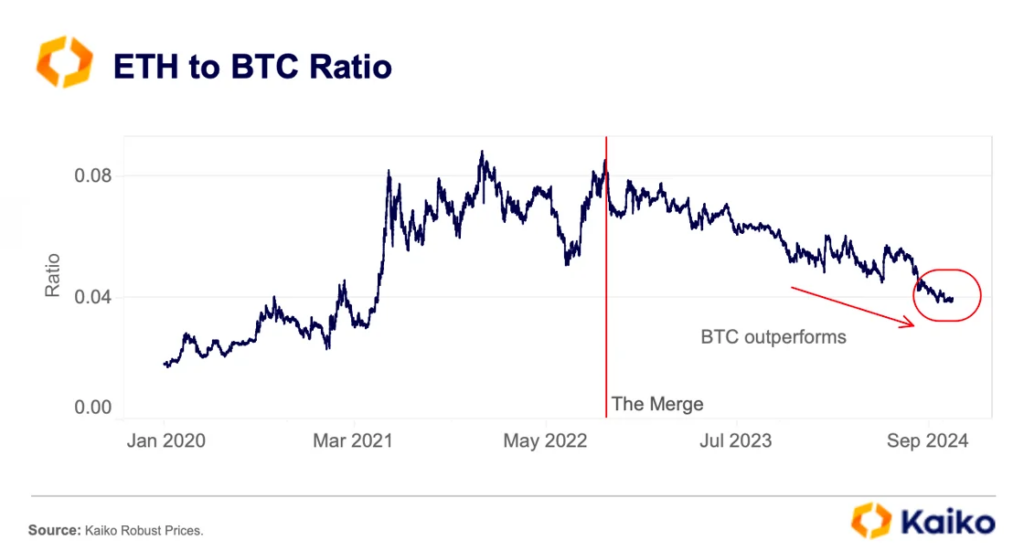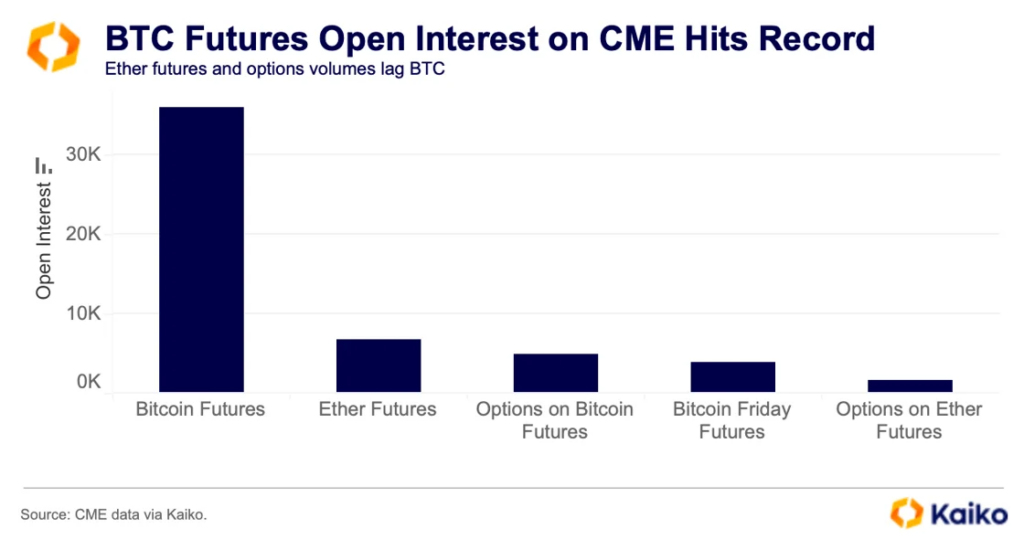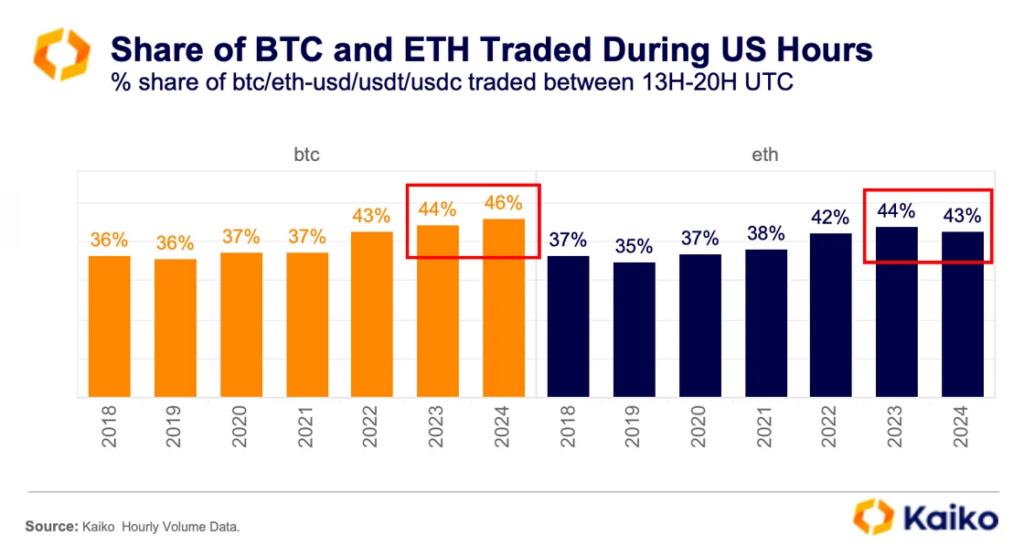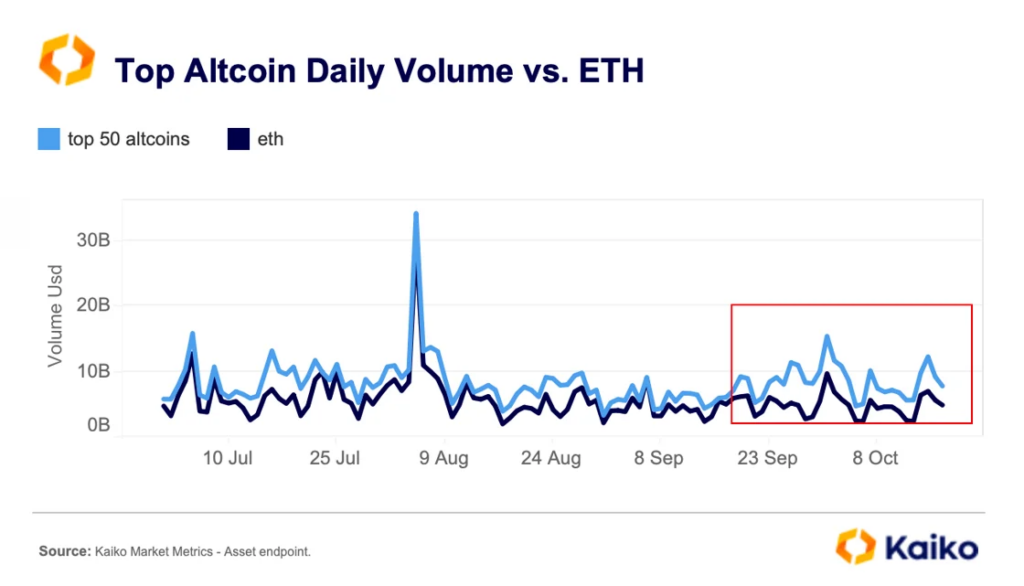-
Ether (ETH) has less institutional demand than Bitcoin (BTC).
-
The ETH market is less mature, according to Kaiko Research.
The market’s top two digital currencies, bitcoin (BTC) and ether (ETH), are experiencing contrasting price performance. Although both have recently benefited from positive macroeconomic conditions, the latter is lagging behind.
The price of bitcoin reached this week the 68,000 dollars (USD), its highest since the end of July. This was driven in part by the US interest rate cut last month. Meanwhile, Ethereum-eth/” target=”_blank” rel=”noreferrer noopener”>ether reached USD 2,700, its highest level since the end of Augustshowing less recovery.
In addition, bitcoin maintains a 60% increase so far in 2024 and is trading at 8% of its all-time high of USD 73,700 recorded in March. On the other hand, ether registers a rise of 15% this year, currently being 46% below its record of USD 4,900 reached in 2021.
The ETH-BTC ratio, which compares the performance of the two assets, has persistently declined since Ethereum’s upgrade called Merge. When this metric drops it shows that ether is underperforming bitcoin.
In October, ETH-BTC ratio fell below 0.04, its lowest point since April 2021. This can be seen in the following graph from the market analysis company Kaiko.


Relationship of ETH and BTC. Source: Kaiko.
According to a report from analytics company, Kaiko, published October 21, There are several reasons why the performance of these currencies shows such contrast. One of the main reasons for this persistent gap is the slower growth of institutional demand for Ethereum compared to bitcoin.
The July introduction of ETH exchange-traded funds (ETFs) in the United States “received a mixed reaction,” Kaiko maintains. While this may be assumed to be a bullish sign for the market, in practice this has not materialized. In fact, at the moment, these instruments they register USD 500 million of departures.


Daily capital flow of ETH ETFs in the United States since their launch. Fountain: Sosovalue.
“Bitcoin’s first-mover advantage among large trading platforms and wealth advisor networks has also contributed to its relative outperformance,” the analyst firm says.
It deepens that many advisors began to present BTC to their clients since last year in anticipation of the ETFs of bitcoin. These instruments were launched in the United States in January 2024, which have since generated revenues of USD 21 billion.
Furthermore, Kaiko highlights that The lack of ETH staking capabilities in ETFs has made them relatively less attractive for both retail and institutional traders.
Initially, ETFs were going to offer exposure in stakingwhich refers to the actor holding ETH deposited in exchange for returns. However, this feature, which was attractive to differentiate itself from those of bitcoin, was not allowed for the approval of the instruments.
The Ethereum market is not so mature
Something to also keep in mind is that the open interest of futures of bitcoin on the CME exchange reached all-time highs. Meanwhile, ether remains relatively low at 7,300 contracts.
This suggests a less mature market for Ethereum and much less institutional interest in ETH futures, Kaiko notes. This is because those who access such instruments are mainly institutional and professional retail investors. Therefore, it works as an indicator of your view of the market.
This metric, which functions as an indicator of institutional interest, suggests a less mature market for Ethereum and much lower institutional interest in ETH futures.


Bitcoin and ether open interest. Source: Kaiko.
The increased interest of American investors in bitcoin is also evident when looking at its trading during United States time. This reached an all-time high between October 2023 and early 2024. On the contrary, this participation has decreased for ETH, as the following graph shows.


Proportion of BTC and ETH trading during US time. Source: Kaiko.
Demand for ETH has also been slow in the spot markets, that is, direct trading of the Cryptocurrency. In October, it had lower trading volume than most altcoins. In fact, the volume gap between ETH and the top 50 altcoins increased to its highest level since March, as the chart below exhibits.


Volume per day of altcoins vs. ETH. Source: Kaiko.
“Traders have shown a preference for smaller-cap altcoins, partly due to ETH’s lackluster performance since the Merge,” Kaiko says. In addition, he attributes this to increased competition from “Ethereum killers,” an informal term that refers to networks that compete with Ethereum, such as Solana.
“Investors can gain exposure to Ethereum through various layer 2 solutions built on its network, which have generally outperformed the mainnet,” Kaiko says. Therefore, this may also be causing weakness for the price of the cryptocurrency.
However, for the analyst company, although BTC leads institutional adoption, US presidential elections may benefit ETH. The reason for this is that such an event could lead to a reduction in regulatory risks for the industry, since both candidates have shown their supportwhich CriptoNoticias reported.
“The Ethereum ecosystem is also constantly evolving, which could impact the adoption and value proposition of ETH in the future,” Kaiko further clarifies. Therefore, he anticipates that its performance may improve compared to bitcoin depending on development.
Crypto Keynote USA
For the Latest Crypto News, Follow ©KeynoteUSA on Twitter Or Google News.






